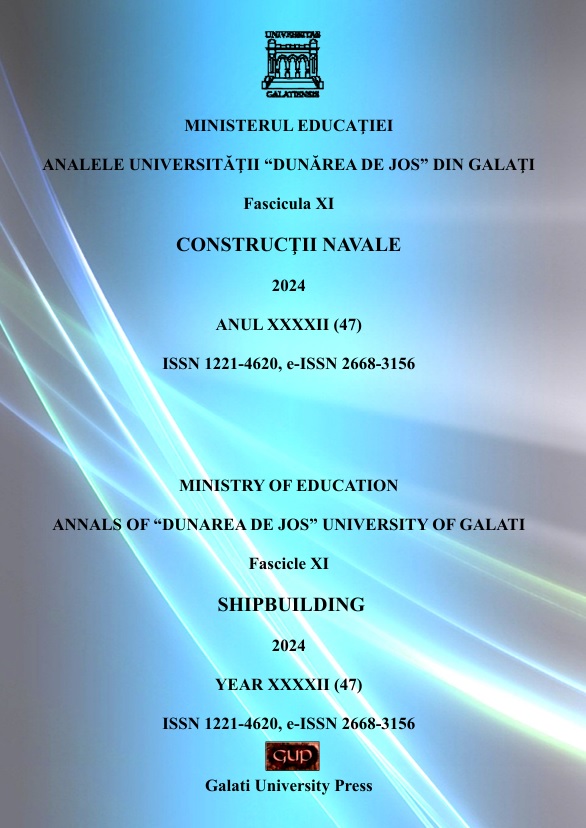Harnesing wind power in maritime shipping: A comparative analysis of innovative hull design and retrofitted solutions for decarbonisation
Abstract
The maritime sector, responsible for approximately 2.5% of global carbon dioxide emissions, faces mounting pressure to implement sustainable practices in line with international decarbonization goals. Wind energy has emerged as a promising solution, with innovative applications being explored to enhance fuel efficiency and reduce emissions. This study undertakes a comparative evaluation of two vessels—Vindskip and Pyxis Ocean—that integrate wind power through distinct technological approaches. Vindskip utilizes an aerodynamic hull design, functioning as a large airfoil to harness wind energy directly for propulsion. This innovative concept has the potential to achieve fuel savings of up to 60% and greenhouse gas emission reductions of approximately 80%. In contrast, Pyxis Ocean employs a wind-assisted propulsion system, utilizing rigid OceanWings sails as a supplementary energy source. This retrofitting approach enables fuel consumption
reductions of around 30%, offering a scalable and practical solution for existing vessels. The comparative analysis examines these vessels across critical performance metrics, in cluding energy efficiency, emissions reduction, scalability, and technological maturity. Vindskip exemplifies a forward-looking design for next-generation maritime operations, while Pyxis Ocean demonstrates the feasibility of integrating renewable energy technologies into current fleets. The findings highlight the complementary roles of innovative vessel designs and retrofitting solutions in advancing the maritime industry’s transition to ward a sustainable and low-emission future.
Downloads
References
[2]. Rusu, E., “Marine Renewable Energy and the Transition to a Low-Carbon Future”, Journal of Marine Science and Engineering, 12(4), 568.,
https://doi.org/10.3390/jmse12040568 2024;
[3]. Barbu, F., Rusu, E., “A review of the harvesting methods for offshore renewable energy – advances and challenges”, Journal of Marine Technology and Environment, 2, 717, 2024; https://doi.org/10.53464/JMTE.02.2024.01
[4]. Wind Power at Sea: The Vindskip Merchant Ship | HeroX. (f.a.); https://www.herox.com/blog/195-wind power-at-sea-the-vindskip-merchant-ship
[5]. Cargill Reports Encouraging Results from 6 Month Sail Test on Bulker. (f.a.). The Maritime Executive. https://maritime executive.com/article/cargill-reports encouraging-results-from-6-month-sail-test on-bulker;
[6]. Bilgili, L., and Ölçer, A. I., “IMO 2023 strategy-Where are we and what’s next?” Marine Policy, 160, 105953, 2024; https://doi.org/10.1016/j.marpol.2023.10595 3
[7]. Qi, J., Wang, H., & Zheng, J., “Promoting Liquefied Natural Gas (LNG) Bunkering for Maritime Transportation: Should Ports or Ships Be Subsidized?” Sustainability, 14(11), 6647, https://doi.org/10.3390/su14116647 2022;
[8]. Tillig, F., Ringsberg, J. W., Psaraftis, H. N., & Zis, T., „Reduced environmental impact of marine transport through speed reduction and wind assisted propulsion”, Transportation Research Part D: Transport and Environment, 83, 102380, 2020; https://doi.org/10.1016/j.trd.2020.102380
[9]. Khan, L., Macklin, J. J. R., Peck, B. C. D., Morton, O., & Souppez, J.-B. R. G., “A REVIEW OF WIND-ASSISTED SHIP PROPULSION FOR
SUSTAINABLECOMMERCIAL SHIPPING: LATEST DEVELOPMENTS AND FUTURE STAKES”, Wind Propulsion, 2021; https://doi.org/10.3940/rina.win.2021.05
[10]. Chou, T., Kosmas, V., Acciaro, M., Renken, K., “A Comeback of Wind Power in Shipping: An Economic and Operational Review on the Wind-Assisted Ship Propulsion Technology”, Sustainability, 13(4), 1880, 2021; https://doi.org/10.3390/su13041880
[11]. Ghorbani, M. T., Slaets, P., Lacey, J., “A numerical investigation of a wind-assisted ship to estimate fuel savings”, OCEANS - Chennai, 1–10,
2022; https://doi.org/10.1109/OCEANSChennai45 887.2022.9775386
[12]. Al Baroudi, H., Awoyomi, A., Patchigolla, K., Jonnalagadda, K., Anthony, E. J., “A review of large-scale CO2 shipping and marine emissions management for carbon capture, utilisation and storage”, Applied Energy, 287, 116510, 2021; https://doi.org/10.1016/j.apenergy.2021.116 510
[13]. Malzer, T., Ecker, L., Schöberl, M., “Energy-based Control and Observer Design for higher-order infinite-dimensional Port Hamiltonian Systems”,
© Galati University Press, 2024 IFAC Papers On Line, 54(19), 44–51, 2021; https://doi.org/10.1016/j.ifacol.2021.11.053
[14]. Pyxis Ocean Makes First Docking with Metal Sails., 2023. MarineLink. https://www.marinelink.com/news/pyxis ocean-makes-first-docking-metal-508366;
[15]. New technology uses good old-fashioned wind to power giant cargo vessels.,2023, KOSU; https://www.kosu.org/energyenvironment/2023-10-05/new-technologyuses-good-old-fashioned-wind-to-powergiant-cargo-vessels
[16]. Wang, Y., Wright, L. A., “A Comparative Review of Alternative Fuels for the Maritime Sector: Economic, Technology, and Policy Challenges for Clean Energy Implementation”, World, 2(4), 456–481, 2021; https://doi.org/10.3390/world2040029
[17]. Zhang, R., Huang, L., Peng, G., Ma, R., Wang, K., Tian, F., Song, Q., “A novel method of desynchronized operation of sails for ship wind-assisted propulsion system”, Ocean Engineering, 288, 115964, 2023; https://doi.org/10.1016/j.oceaneng.2023.115 964
[18]. Werner, S., Nisbet, J., Hörteborn, A., Nielsen, R., “SPEED TRIAL VERIFICATION FOR A WIND ASSISTED SHIP”, Wind Propulsion 2021;
https://doi.org/10.3940/rina.win.2021.09
[19]. Arief, I. S., Fathalah, A., “Review Of Alternative Energy Resource For The Future Ship Power”, IOP Conference Series: Earth and Environmental Science, 972(1), 012073, 2022. https://doi.org/10.1088/1755 1315/972/1/012073




